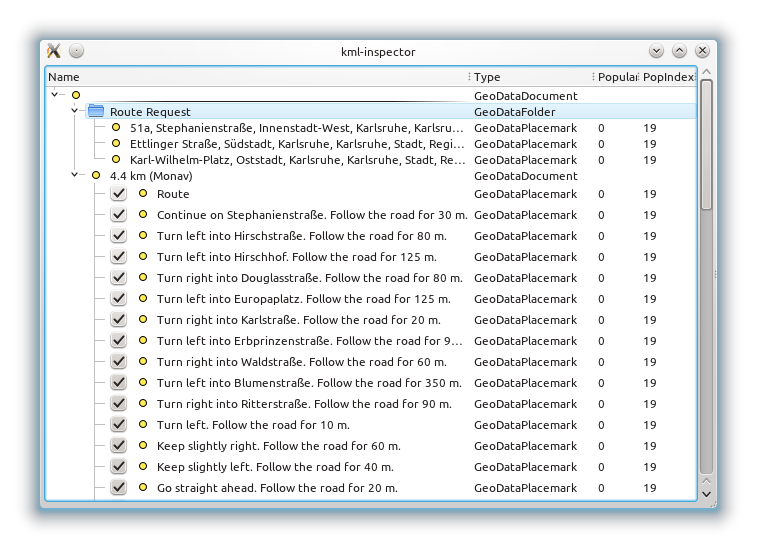Marble/Runners/Parse
< Marble
Search
| Tutorial Series | Marble C++ Tutorial |
| Previous | Tutorial 11 - Reverse Geocoding |
| What's Next | Tutorial 13 - Painting onto the map |
| Further Reading | n/a |
KML Inspector
As we have seen in the previous tutorial, Marble employs runners to when dealing with .kml (or .gpx, .osm, etc) files. This tutorial shows how to use the MarbleRunnerManager class to open a .kml (or .gpx, ...) file and display its structure in a tree view.
#include <QtCore/QDebug>
#include <QtCore/QFileInfo>
#include <QtGui/QApplication>
#include <QtGui/QTreeView>
#include <marble/MarbleWidget.h>
#include <marble/MarbleModel.h>
#include <marble/MarbleRunnerManager.h>
#include <marble/GeoDataTreeModel.h>
using namespace Marble;
int main(int argc, char** argv)
{
QApplication app(argc,argv);
QFileInfo inputFile( app.arguments().last() );
if ( app.arguments().size() < 2 || !inputFile.exists() ) {
qWarning() << "Usage: " << app.arguments().first() << "file.kml";
return 1;
}
MarbleModel *model = new MarbleModel;
MarbleRunnerManager* manager = new MarbleRunnerManager( model->pluginManager() );
GeoDataDocument* document = manager->openFile( inputFile.absoluteFilePath() );
if ( document ) {
GeoDataTreeModel* treeModel = new GeoDataTreeModel;
treeModel->addDocument( document );
QTreeView* treeView = new QTreeView;
treeView->setModel( treeModel );
treeView->show();
} else {
qDebug() << "Unable to open " << inputFile.absoluteFilePath();
}
return app.exec();
}Copy and paste the code above into a text editor. Then save it as my_marble.cpp and compile it by entering the following command on the command line:
g++ -I /usr/include/qt4/ -o my_marble my_marble.cpp -lmarblewidget -lQtGui -lQtCore
If things go fine, execute ./my_marble some-file.kml and you get a tree view of its structure similar to this screenshot (showing the structure of a route calculated with Marble):
Tip
Here's a little checklist to tackle some problems that might arise when compiling the code above:
- You need Qt and Marble development packages (or comparable git installations), version 1.3 (Marble library 0.13), shipped post KDE 4.8
- If Qt headers are not installed in /usr/include/qt4 on your system, change the path in the g++ call above accordingly.
- Likewise, add -I /path/to/marble/headers if they're not to be found in /usr/include
Note
If you provide maps in your application please check the Terms of Use of the map material. The map material that is shipped with Marble is licensed in the spirit of Free Software. This usually means at least that the authors should be credited and that the license is mentioned.
E.g. for OpenStreetMap the license is CC-BY-SA. Other map data shipped with Marble is either public domain or licensed in the spirit of the BSD license.

